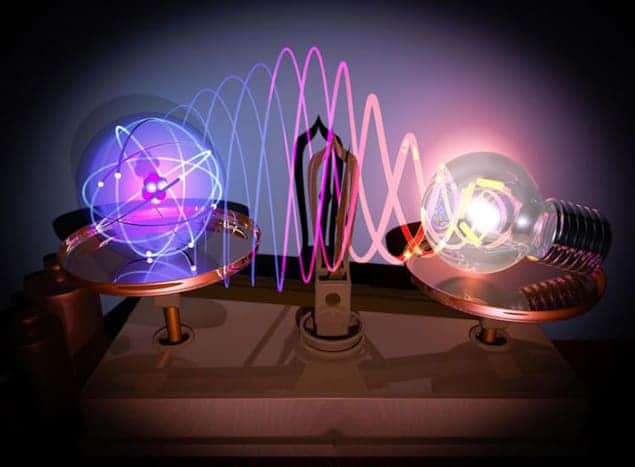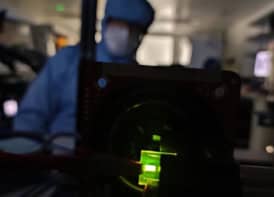
Light has been confined to volumes smaller than the size of a single atom for the first time. The feat, which seemed completely impossible even just a few years ago, has been achieved by researchers in the UK and Spain. They say that the “picocavity” that confines the light can be thought of as the world’s smallest magnifying glass. It could be used to study how light and matter interact at tiny scales and even to observe individual chemical bonds forming and breaking between atoms. The technique could also be used to make new optomechanical data-storage devices in which information can be written and read by light and stored in the form of molecular vibrations.
For a long time, scientists thought that visible light could not be focused to a spot that is less than half its wavelength – the so-called diffraction limit. In recent years, however, they have learnt how to use nanostructured metals like gold and silver that support surface plasmons (oscillations of electrons at the metal surface) to confine optical fields to much smaller spaces than their wavelength in free space would allow.
Now, a team led by Jeremy Baumberg at the University of Cambridge in the UK has used gold nanoparticles to make the world’s tiniest optical cavity. This cavity is so small that only a single atom can fit in it. “We will never do any better than this,” says Baumberg.
A nanoparticle-on-mirror
The researchers made their cavity in two steps. First, they made a sandwich structure that they called a nanoparticle-on-mirror. To do this, they lay down a flat mirror of gold and then coated it with a layer of molecules that like to stick to it. On top of this, they scattered gold particles that are 80 nm across and nearly spherical.
“This structure confines light with a specific red colour that is resonantly trapped in the gap between sphere and mirror,” explains Baumberg. “However, the light confined here is still a hundred times larger than we want.
“The next stage is more magical,” he continues. “We have been trying to understand how these samples behave, so we cooled them down to liquid-helium temperatures (10° above absolute zero) to try and stop all motion of molecules and atoms. Then, when we shone laser light on them, we noticed a peculiar thing.
“Occasionally, the light scattered from molecules became thousands of times stronger for many seconds, before disappearing. We found that what happens is that individual molecules from the gold are pulled by the light out of the bulk facet to sit on the surface. These atoms stuck on the flat surface act a little like lightning rods (but for light, not static electric fields) and trap light just above their tip. The trapped light has a volume of less than 1 nm cubed, so we call it a picocavity.”
Observing single bonds
Since the volume of this cavity is so small, it takes light almost no time to circulate around it, he adds. This increases all of the interactions between the light and the objects inside – in this case, biphenyl-4-thiol molecules. “It is also so small that it preferentially interacts with just a single bond within a molecule, allowing us to study it better. We can see that as we shine more light on it, we set the bond vibrating harder, and the molecule starts to deform.”
According to the team, which includes researchers from the Center for Materials Physics in San Sebastian in Spain, the new cavity could be used to study how molecules and metal atoms behave at very short length scales. This is very hard to do under ambient conditions with electron microscopy, for example. “Here, we directly see their motion in real time,” Baumberg tells nanotechweb.org. “We hope that this will allow us to understand how chemical reactions work for molecules attached to surfaces,” explains Baumberg, adding “This is of major importance for all the chemicals we use as a society today, since they are made using catalysis at a metal surface.”
Changing colour
Baumberg also points out that the ultrasmall-sized cavities “provide us with a way of making optoelectronic switches that change colour when we inject just a tiny amount of energy into the picocavity – either by light or electricity”.
Writing in Science, the researchers say they are now busy looking at what happens when they increase the laser power and how they can start to bend and break the molecules. “We are also trying to understand how light moves around the gold atoms and if we can control this with much more precision, to build objects on the nanoscale,” says Baumberg.
- A version of this article first appeared on nanotechweb.org



